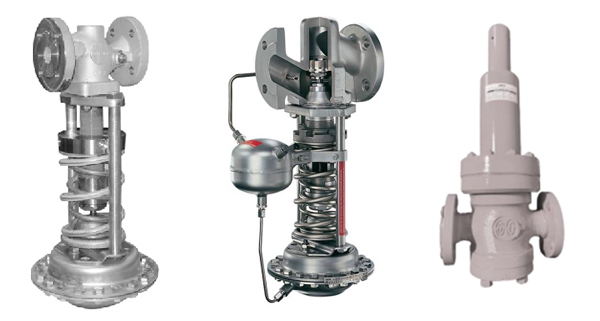
Description
Self Actuated Pressure Reducing Valves
Suitable for Steam,Water, Air, Nitrogen, Oils, other non flammable gases.
Valve sizes : 1/2"to 4"ANSI 150#/300#.
Accurate set pressure achievement inspite of Pressure/Flow fluctuations due to Bellows Balancing design.
Best suitable for Steam Pressure Reducing Stations. IBR Approved.
Actuator Diaphragms in EPDM/Viton.
Seal pots for Steam service.
Easy set point setting.
Maintenance free and less spare parts requirement.
Upstream Pressure Regulators
Suitable for Steam, Water, Air, Nitrogen, Oils, other non flammable gases.
Valve sizes : 1/2"to 4"ANSI 150#/300#.
Accurate set pressure achievement inspite of Pressure/Flow fluctuations due to Bellows Balancing design.
Best suitable for Steam Pressure Reducing Stations. IBR Approved.
Actuator Diaphragms in EPDM/Viton.
Seal pots for Steam service.
Easy set point setting.
Maintenance free and less spare parts requirement.
Back Pressure Regulator.
Pressure regulators are devices used to control and maintain a desired pressure level in a fluid system. They are commonly employed in various industries and applications to ensure consistent and safe operation of equipment and processes. Pressure regulators work by reducing the inlet pressure to a lower, predetermined set pressure and maintaining that set pressure within a specific range. Here are some key features and types of pressure regulators :
1. Pressure Setting and Adjustment : Pressure regulators allow users to set and adjust the desired outlet pressure according to system requirements. They typically feature an adjustment mechanism, such as a knob or screw, that changes the spring tension or the position of a diaphragm to control the outlet pressure.
2. Spring-Loaded Design : Most pressure regulators utilize a spring-loaded mechanism to control pressure. The inlet pressure acts against a spring, and as the pressure exceeds the set point, the spring force opposes it, reducing the outlet pressure. When the outlet pressure drops below the set point, the spring force allows the inlet pressure to flow through the regulator, maintaining the desired pressure.
3. Diaphragm or Piston Operation : Pressure regulators can use a diaphragm or piston as the controlling element. A diaphragm is a flexible membrane that responds to pressure changes, while a piston moves in response to pressure differentials. Both diaphragm-based and piston-based regulators are commonly used, depending on the specific application requirements.
4. Direct-Acting and Pilot-Operated Regulators : Pressure regulators can be categorized as direct-acting or pilot-operated. Direct-acting regulators use the force of the inlet pressure directly on the diaphragm or piston to control the outlet pressure. Pilot-operated regulators utilize a smaller auxiliary pressure, known as the pilot pressure, to assist in regulating the main pressure. Pilot-operated regulators offer higher flow capacities and better accuracy in certain applications.
5. Single-Stage and Two-Stage Regulators : Single-stage regulators reduce the pressure from the inlet to the desired set point in one step. Two-stage regulators, on the other hand, have an additional intermediate pressure stage between the inlet and outlet. Two-stage regulators provide more precise control, especially for applications with large pressure differentials or fluctuating inlet pressures.
6. Materials of Construction : Pressure regulators are available in a range of materials to suit different operating conditions and fluid compatibility requirements. Common materials include brass, stainless steel, aluminum, and various plastics or elastomers. The choice of material depends on factors such as the nature of the fluid being regulated, temperature, pressure, and environmental conditions.
7. Specialized Regulators : Some pressure regulators are designed for specific applications or industries. For example, high-pressure regulators are used in gas cylinders or industrial gas systems, while low-pressure regulators are used in HVAC systems or pneumatic tools. Specialty regulators may have additional features like built-in filters, relief valves, or pressure gauges.
